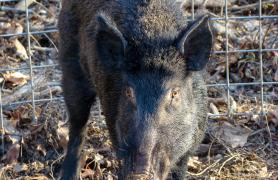The world has been blessed by many outstanding architects. Most people recognize Leonardo da Vinci, Michelangelo, and Frank Lloyd Wright, but frequently overlook the Baltimore orioles that weave their intricate nests, the potter wasps that produce their tiny clay pots, and the spiders, the oh so many spiders, that spin their webs.
Missouri has over 400 species of spiders, but not all of them spin webs. Of those that do, hours could be spent talking about their abilities to weave their masterpieces, from the large orb webs of the black and yellow garden spiders (Argiope aurantia) to the delicate webs of the bowl and doily spider (Frontinella pyramitela). However, some survive by hiding their silken homes in plain sight.
The Hidden Home
Trapdoor spiders and purseweb spiders spend most of their lives in their hidden homes. Both live in silk-lined burrows, with the trapdoor spider’s home ending at the surface with either a camouflaged folding door found in the turret spiders (Antrodiaetids) or a cork lid covering built by the trapdoor spider (Ummidia). The purseweb spider constructs tough silken tubes carefully disguised with dirt, bits of lichen and moss, that extend up the sides of tree trunks or along the ground 6–12 inches.
Like all tarantulas, the redlegged purseweb spider (Sphodros rufipes) is stocky, built low to the ground with short strong legs. The female is a little larger than a quarter and the male a little smaller. Females are plump with a black cephalothorax (head and chest area), eight black legs, and a dark chocolate to chocolate brown abdomen. Males are easily distinguished from the females, being much sleeker with a black cephalothorax, smaller abdomen, and bright crimson legs.
When a purseweb spider is first encountered, everyone’s initial response to them is reminiscent of Little Red Riding Hood to the wolf, “what big teeth you have.” A spider’s “teeth” are called fangs, and the entire jaw unit is called the chelicerae. In the purseweb spider, the chelicera and the paraxial fangs are quite large. These fangs are disproportionate to the overall size of the spider — almost a third of the size of males and a little less in females. This aides in their unique hunting strategy.
Redlegged purseweb spiders build their tubes upright and attached to hardwood trees in their natural habitat of deciduous forests or woodlots, typically on north or east facing slopes. However, they are quite adaptable and have been found in urban areas on buildings or fences. As mentioned above, these spiders spend most of their lives (four to 10-plus years) in these silk-lined burrows. Females rarely, if ever, leave, while males leave to seek out females when they become sexually mature. Their tubes serve as shelter from weather and potential predators. They also serve as well disguised hunting blinds.
Camouflage and Stealth
Unlike other spiders that rely on their prey to get stuck in their webs, purseweb spiders use camouflage and stealth to acquire their meals. The silk tubes covered in dirt, lichens, and moss are attached to the tree. This attachment is only at the top, allowing the spider to feel every movement on the tube. A potential prey walks over the exposed portion of the tube, and the spider, sensing vibrations, attacks it from within the tube by impaling it with its enormous fangs. Once the prey is subdued, the spider, holding it with one fang, cuts a slit in the tube with the other and pulls the prey inside to consume it at its leisure. Then the spider repairs the tube by stitching up the hole. All of this is done without the spider ever leaving the protection of the tube. Leaving the tube would leave the spider susceptible to predation from birds, mammals, insects, and other spiders.
Never leaving the tube is safe, but it complicates the spider’s lifestyle. Living in the same tube for several years and using it as your grocery store, kitchen, and dining room can cause a housekeeping nightmare. All mygalomorphs macerate their food, meaning they begin the digestive process by injecting their prey with enzymes that liquify the soft tissue, allowing the spider to suck out the liquified flesh and tissue. So, after the spider is done eating, the main course is left in a heap of body parts consisting primarily of the insect’s hard chitinous outer shell. The spider takes it to the top of the tube and dumps as much of it out of its tube as possible. Other parts fall to the bottom of the tube and become the floor covering in the home.
Space also can be a problem as the spider grows. Instead of moving out of their current home, they add on to their existing residence. Although it is unknown how they do this, we know they cut their web to drag their food into the purse. We can assume that they expand the tubes in similar fashion by cutting the tube and repairing it with additional silk.
A Deadly Dating Game
Since the females never leave their burrows, and eat almost everything that touches the tube, mating is tricky for the males. After the male’s final molt, they become sexually mature and begin roaming to find their partner. In Missouri, this usually happens in June. It is believed that a chemical scent called pheromones attracts the male to the female’s web. Once he locates the tube,he must be very careful, tapping at the outside of the tube in a way that indicates he isn’t prey. After tapping for a while and not being eaten, he enters the tube. Ultimately, whether he’s eaten or not will be up to her. If the female inside isn’t ready to mate or has already mated, she won’t hesitate to eat him when he attempts to enter the burrow.
Once mating occurs, eggs are laid, hatched, and remain in the tube with the female until it is time for them to leave. Some believe this is later in the fall, others believe they overwinter in the tube and leave in the spring, and still others believe that it is one year later. But, those are secrets that only the spiders know today.
The next time you are out in the woods hunting or just admiring the natural world around you, look for those architectural wonders of the natural world hidden in plain sight.
Missouri’s Spiders
Missouri’s spiders come in two types, Mygalomorphae (tarantula like) and Araneomorphae (true spiders). Differences in these two groups are many, but one of the biggest differences is how their fangs work. Mygalomorphs have paraxial fangs, which work like those of a rattlesnake. True spiders have diaxial fangs, which work like a pair of pliers. Paraxial stab; diaxial pinch. Those in the mygalomorph group include our native tarantula, two families oftrapdoor spiders, and three species of purseweb spiders.
Mygalomorphs are long-lived spiders compared to their cousins, the true spiders. It takes several years for them to become sexually mature. Unlike our native tarantula, very little is known about Missouri’s smaller versions, but scientists believe they can live up to 10 years. Males live shorter lives, dying shortly after becoming sexually mature.














Also In This Issue


And More...
This Issue's Staff
Editor - Angie Daly Morfeld
Associate Editor - Larry Archer
Staff Writer - Bonnie Chasteen
Staff Writer - Heather Feeler
Staff Writer - Kristie Hilgedick
Staff Writer - Joe Jerek
Art Director - Cliff White
Designer - Shawn Carey
Designer - Les Fortenberry
Designer - Marci Porter
Photographer - Noppadol Paothong
Photographer - David Stonner
Circulation - Laura Scheuler






















